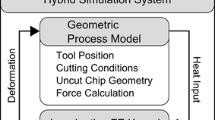Abstract
Due to friction and material deformation in the shear zone, workpieces in NC-milling processes are subjected to heat input and thermal loading. Ongoing geometric changes as well as time-varying contact and cutting conditions result in an inhomogeneous temperature field that is constantly in flux. Such thermally loaded workpieces often exhibit complex and transient thermomechanical deformations, which may result in erroneous material removal with respect to the desired shape. In order to meet critical manufacturing tolerances, it is therefore necessary to avoid and compensate these effects. Predicting the deformation exhibited by a thermally loaded workpiece is a problem of linear thermoelasticity, which can be solved by use of the finite element (FE) method. A prerequisite to this is the accurate calculation of the temperature field that results within the workpiece material during the course of the milling process. Although the FE method may be used for this as well, the practical application to realistic milling processes is limited due to the required computational resources. This paper presents a fast geometric process simulation for the prediction of cutting forces, heat input and thermal loading in dry NC milling. The temperature field of the workpiece is continuously updated, such that it is possible to determine the temperature of any material point at any point in time of the milling process. Individual models comprising the simulation system are described in detail, along with the experiments that are required to calibrate them. The accuracy of the geometric process simulation is validated by comparison with experimental data for a non-trivial milling process.











Similar content being viewed by others
References
Arrazola P, Özel T, Umbrello D, Davies M, Jawahir I (2013) Recent advances in modelling of metal machining processes. CIRP Ann Manuf Technol. doi:10.1016/j.cirp.2013.05.006
Davies M, Ueda T, M’Saoubi R, Mullany B, Cooke A (2007) On the measurement of temperature in material removal processes. CIRP Ann Manuf Technol. doi:10.1016/j.cirp.2007.10.009
Denkena B, Böß V (2009) Technological NC simulation for grinding and cutting processes using cuts. In: Proceedings of the 12th CIRP conference on modeling of machining operations, vol 2, pp 563–574. ISBN:978-84-608-0866-4
Denkena B, Schmidt A, Henjes J, Niederwestberg D, Niebuhr C (2013) Modeling a thermomechanical NC-simulation. Proc CIRP. doi:10.1016/j.procir.2013.06.067
Gulpak M, Sölter J, Brinksmeier E (2013) Prediction of shape deviations in face milling of steel. Proc CIRP. doi:10.1016/j.procir.2013.06.058
Joliet R, Byfut A, Kersting P, Schröder A, Zabel A (2013a) Validation of a heat input model for the prediction of thermomechanical deformations during NC milling. In: 14th CIRP conference on modeling of machining operations (CIRP CMMO). doi:10.1016/j.procir.2013.06.124
Joliet R, Byfut A, Surmann T, Schröder A (2013) Incremental generation of hierarchical meshes for the thermomechanical simulation of NC-milling processes. In: 8th CIRP conference on intelligent computation in manufacturing engineering. doi:10.1016/j.procir.2013.09.006
Kienzle O (1952) Die Bestimmung von Kräften und Leistungen an spanenden Werkzeugen und Werkzeugmaschinen. VDI-Z 94(11–12):299–306
Mackerle J (1999) Finite-element analysis and simulation of machining: a bibliography (1976–1996). J Mater Process Technol. doi:10.1016/S0924-0136(98)0227-1
Odendahl S, Kersting P (2013) Higher efficiency modeling of surface location errors by using a multi-scale milling simulation. Proc CIRP. doi:10.1016/j.procir.2013.06.161
Schindler S, Zimmermann M, Aurich JC, Steinmann P (2014) Thermo-elastic deformations of the workpiece when dry turning aluminum alloys: a finite element model to predict thermal effects in the workpiece. CIRP J Manuf Sci Technol 7(3):233–245. doi:10.1016/j.cirpj.2014.04.006
Smolenicki D, Boos J, Kuster F, Wegener K (2012) Analysis of the chip formation of bainitic steel in drilling processes. In: 5th CIRP conference on high performance cutting. doi:10.1016/j.procir.2012.05.027
Surmann T, Ungemach E, Zabel A, Joliet R, Schröder A (2011) Simulation of the temperature distribution in NC-milled workpieces. Adv Mater Res 223:222–230. doi:10.4028/www.scientific.net/AMR.223.222
Acknowledgments
This paper is based on investigations and findings of the project Simulation of Thermomechanical Deformations in NC Milling (ZA 427/3-3) of the priority program SPP 1480 (CutSim) which is kindly supported by the German Research Foundation (DFG).
Author information
Authors and Affiliations
Corresponding author
Rights and permissions
About this article
Cite this article
Schweinoch, M., Joliet, R., Kersting, P. et al. Heat input modeling and calibration in dry NC-milling processes. Prod. Eng. Res. Devel. 9, 495–504 (2015). https://doi.org/10.1007/s11740-015-0621-z
Received:
Accepted:
Published:
Issue Date:
DOI: https://doi.org/10.1007/s11740-015-0621-z



